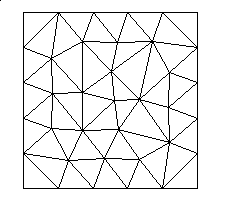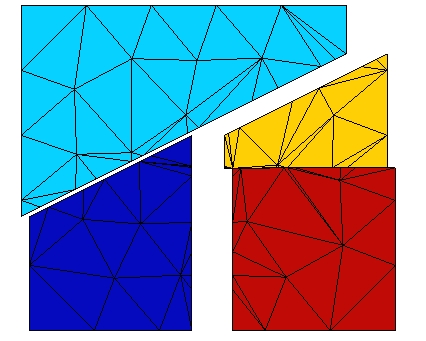4. B modeling#
4.1. Characteristics of modeling#
It is the same modeling as modeling A, but with plane constraints (C_ PLAN). The junctions are constructed in the same way.
4.2. Characteristics of the mesh#
The mesh, which comprises 54 cells of the TRIA3 type, is represented in FIG. 4.2-a. The mesh is sufficiently unrefined to be in the same situation as for modeling A (Figure 4.2-b).

Figure 4.2-a: The modeling B mesh.

Figure 4.2-b: Heaviside function value for the horizontal crack and its support.
4.3. Tested sizes and results#
The quantities tested are identical to those presented for modeling A.
Identification |
Reference |
% tolerance |
1.00E-11 |
|
DEPZON_1 |
DX |
MIN |
-0.25 |
|
MAX |
-0.25 |
1.00E-11 |
||
DY |
MIN |
0 |
1.00E-11 |
|
MAX |
0 |
1.00E-11 |
||
DEPZON_2 |
DX |
MIN |
-0.5 |
1.00E-11 |
MAX |
-0.5 |
1.00E-11 |
||
DY |
MIN |
0 |
1.00E-11 |
|
MAX |
0 |
1.00E-11 |
||
DEPZON_3 |
DX |
MIN |
0.75 |
1.00E-11 |
MAX |
0.75 |
1.00E-11 |
||
DY |
MIN |
0 |
1.00E-11 |
|
MAX |
0 |
1.00E-11 |
||
DEPZON_4 |
DX |
MIN |
0.75 |
1.00E-11 |
MAX |
0.75 |
1.00E-11 |
||
DY |
MIN |
0 |
1.00E-11 |
|
MAX |
0 |
1.00E-11 |
||
Table 4.3-1
The deformation is represented in FIG. 4.4-a.

Figure 4.4-a: Deformed structure.
4.4. notes#
The remarks are identical to those specified for modeling A.